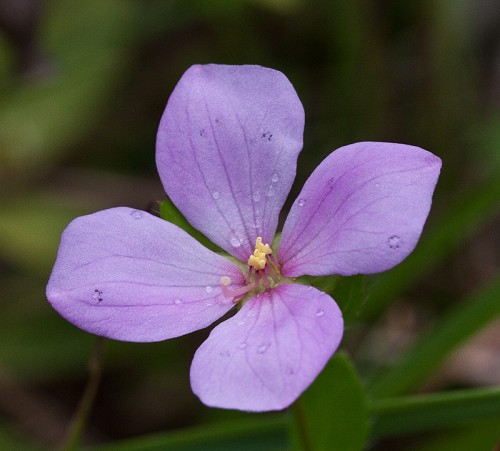Difference between revisions of "Rhexia petiolata"
(→Ecology) |
HaleighJoM (talk | contribs) (→Ecology) |
||
| (One intermediate revision by one other user not shown) | |||
| Line 45: | Line 45: | ||
<!--===Seed dispersal===--> | <!--===Seed dispersal===--> | ||
<!--===Seed bank and germination===--> | <!--===Seed bank and germination===--> | ||
| − | + | ===Fire ecology=== <!--Fire tolerance, fire dependence, adaptive fire responses--> | |
| − | <!--===Pollination and | + | Populations of ''Rhexia petiolata'' have been known to persist through repeated annual burning.<ref>Platt, W.J., R. Carter, G. Nelson, W. Baker, S. Hermann, J. Kane, L. Anderson, M. Smith, K. Robertson. 2021. Unpublished species list of Wade Tract old-growth longleaf pine savanna, Thomasville, Georgia.</ref> |
| − | <!--==Diseases and parasites==--> | + | <!--===Pollination===--> |
| + | <!--===Herbivory and toxicology===<!--Common herbivores, granivory, insect hosting, poisonous chemicals, allelopathy, etc--> | ||
| + | <!--===Diseases and parasites===--> | ||
==Conservation, cultivation, and restoration== | ==Conservation, cultivation, and restoration== | ||
Latest revision as of 15:04, 15 July 2022
Common name: ciliate meadow-beauty [1], short-stemmed meadow-beauty [1], fringed meadowbeauty [2]
| Rhexia petiolata | |
|---|---|

| |
| Photo by John Gwaltney hosted at Southeastern Flora.com | |
| Scientific classification | |
| Kingdom: | Plantae |
| Division: | Magnoliophyta - Flowering plants |
| Class: | Magnoliopsida - Dicots |
| Order: | Myrtales |
| Family: | Melastomataceae |
| Genus: | Rhexia |
| Species: | R. petiolata |
| Binomial name | |
| Rhexia petiolatas Walter | |

| |
| Natural range of Rhexia petiolata from USDA NRCS Plants Database. | |
Contents
Taxonomic Notes
Synonyms: R. ciliosa Michaux
Varieties: none
Description
R. petiolata is a perennial forb/herb of the Melastomataceae family native to North America.[2]
Distribution
R. petiolata is found along the southeastern coast of the United States from Texas to Maryland.[2]
Ecology
Habitat
R. petiolata proliferates in wet pine flatwoods and savannas, pocosin borders, cypress ponds and swamps, slope bogs, marshes, longleaf pine forests, and ditches.[1][3] It is also found in disturbed areas including powerline corridors and burned slash pine woods.[3]
Associated species: Rhynchospora, R. nuttallii, Kalmia hirsuta, Ludwigia, Polygala, and Xyris.[3]
R. petiolata increased its presence in response to soil disturbance by heavy silvilculture in North Carolina longleaf pine sites. It has shown regrowth in reestablished longleaf habitat that was disturbed by these practices.[4] It does not respond to soil disturbance by clearcutting and chopping in north Florida flatwoods forests.[5]
Rhexia petiolata is an indicator species for the Panhandle Seepage Savannas community type as described in Carr et al. (2010).[6]
Phenology
R. petiolata has been observed to flower June through October.[7]
Fire ecology
Populations of Rhexia petiolata have been known to persist through repeated annual burning.[8]
Conservation, cultivation, and restoration
Cultural use
It is possible the greens and tubers can be used in salads for a sweetish, nutty taste.[9]
Photo Gallery
References and notes
- ↑ 1.0 1.1 1.2 Weakley, A. S. (2015). Flora of the Southern and Mid-Atlantic States. Chapel Hill, NC, University of North Carolina Herbarium.
- ↑ 2.0 2.1 2.2 USDA Plant Database https://plants.usda.gov/core/profile?symbol=RHPE
- ↑ 3.0 3.1 3.2 Florida State University Herbarium Database. URL: http://herbarium.bio.fsu.edu. Last accessed: June 2021. Collectors: Loran C. Anderson and R. Kral. States and counties: Florida: Bay, Clay, Franklin, Lee, Levy, and Osceola. Georgia: Thomas.
- ↑ Cohen, S., R. Braham, and F. Sanchez. (2004). Seed Bank Viability in Disturbed Longleaf Pine Sites. Restoration Ecology 12(4):503-515.
- ↑ Moore, W.H., B.F. Swindel, and W.S. Terry. (1982). Vegetative Response to Clearcutting and Chopping in a North Florida Flatwoods Forest. Journal of Range Management 35(2):214-218.
- ↑ Carr, S.C., K.M. Robertson, and R.K. Peet. 2010. A vegetation classification of fire-dependent pinelands of Florida. Castanea 75:153-189.
- ↑ Nelson, G. PanFlora: Plant data for the eastern United States with emphasis on the Southeastern Coastal Plains, Florida, and the Florida Panhandle. www.gilnelson.com/PanFlora/ Accessed: 29 MAY 2018
- ↑ Platt, W.J., R. Carter, G. Nelson, W. Baker, S. Hermann, J. Kane, L. Anderson, M. Smith, K. Robertson. 2021. Unpublished species list of Wade Tract old-growth longleaf pine savanna, Thomasville, Georgia.
- ↑ Fernald, et al. 1958. Edible Plants of Eastern North America. Harper and Row Publishers, New York.